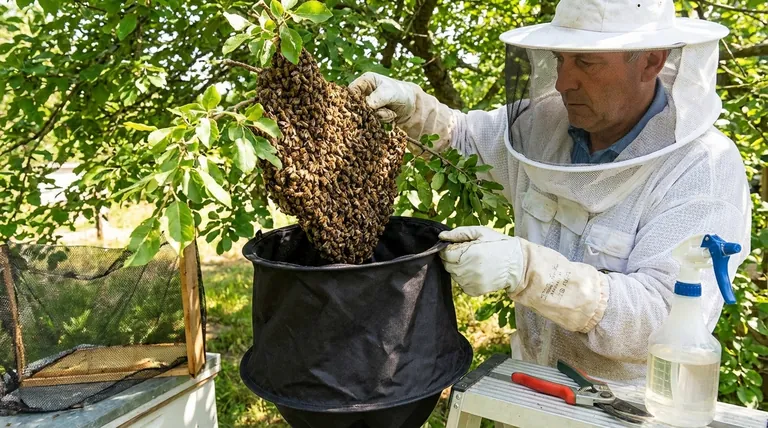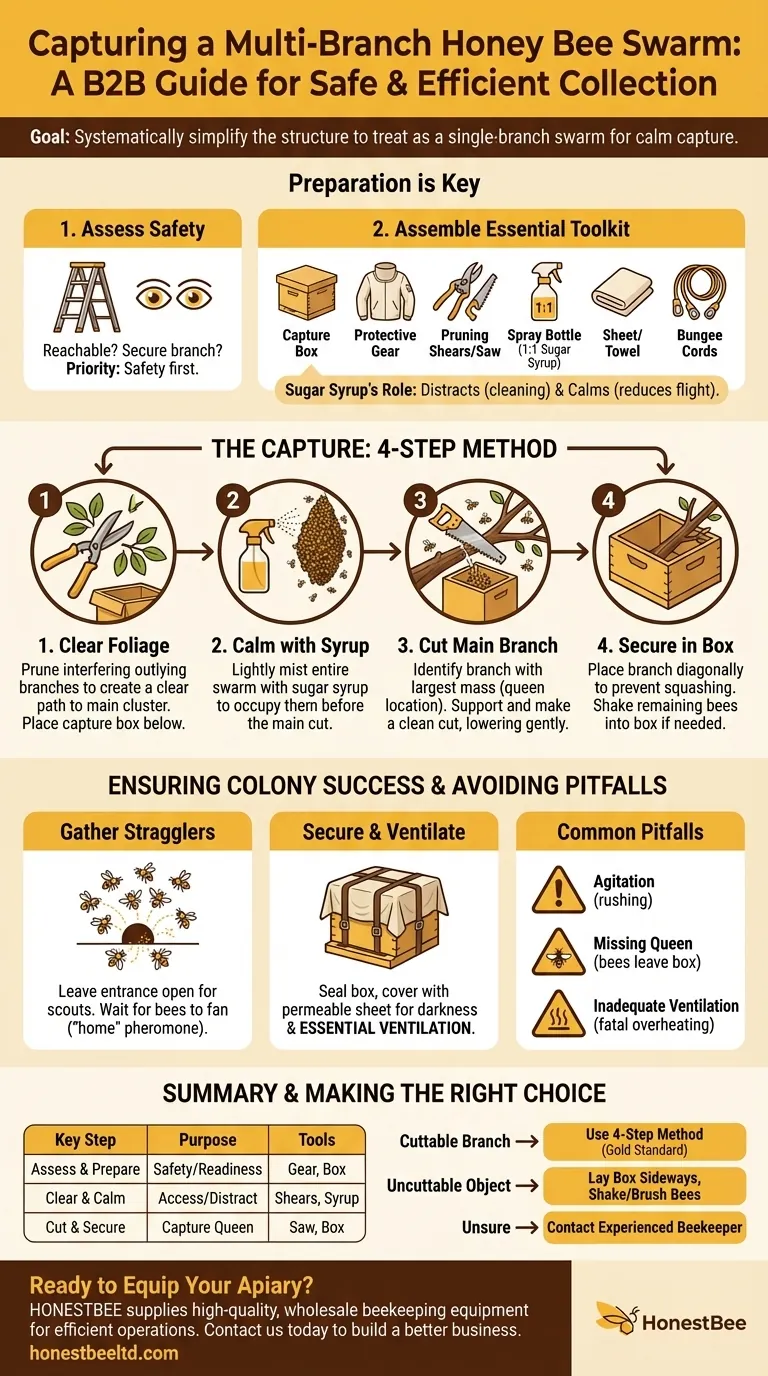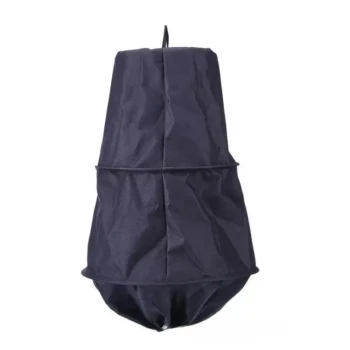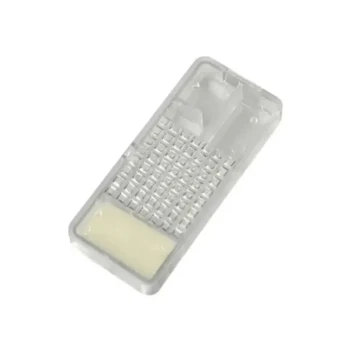To capture a honey bee swarm spread across many branches, the primary steps are to carefully prune away any obstructing foliage, calm the bees with a light mist of sugar syrup, and then cut the main branch holding the majority of the bees. This entire branch is then gently placed inside a capture box, which is sealed for transport while ensuring adequate ventilation.
The core challenge with a multi-branch swarm is not the bees themselves, but the environment. Your goal is to systematically simplify the structure by removing excess branches until you can treat it as a single-branch swarm, ensuring a calm and efficient capture.

Preparing for a Successful Capture
A successful capture depends entirely on calm, methodical preparation. Rushing the process is the most common cause of failure and agitation.
Assess the Situation First
Before grabbing any tools, evaluate the swarm's location. Is it safely reachable with a stepladder? Is the primary branch one you can realistically cut without endangering yourself or property? Safety is your first priority.
Swarms are typically docile, as they have no hive or honey to defend. However, you should always approach with caution and respect.
Assemble Your Essential Toolkit
Having everything on hand prevents delays that can disrupt the process.
You will need:
- A Capture Box: A cardboard "nuc" box or a standard deep hive body is ideal. A sturdy cardboard box can also work.
- Protective Gear: At a minimum, wear a beekeeping veil and gloves. A full suit provides peace of mind.
- Pruning Tools: Sharp pruning shears and a small hand saw are essential for clearing branches.
- Spray Bottle: Filled with a 1:1 sugar syrup (one part sugar, one part water).
- A Sheet or Towel: To cover the box after the capture.
- Bungee Cords or Straps: To secure the cover and the box itself.
The Role of Sugar Syrup: Calm and Containment
Spraying bees with sugar syrup is a critical technique. It does two things: it gives them a task (cleaning themselves and each other), which serves as a powerful distraction. It also makes it slightly more difficult for them to fly, encouraging them to remain clustered.
The Step-by-Step Capture Process
Once your gear is ready and the site is assessed, you can begin the capture. Work slowly and deliberately.
Step 1: Clear the Surrounding Area
Begin by using your pruning shears to cut away the smaller, outlying branches that interfere with your access to the main cluster. The goal is to create a clear path to get your capture box directly under the densest part of the swarm.
Place your capture box on the ground directly beneath the swarm before you begin trimming.
Step 2: Calm the Cluster with Syrup
Before making the main cut, give the entire swarm a light misting of sugar syrup. Don't drench them; a fine spray is all that's needed to get their attention and keep them occupied.
Step 3: Isolate and Cut the Main Branch
Identify the single branch that holds the largest mass of bees. This is almost certainly where the queen is located. With your capture box positioned below, make a clean, decisive cut on this branch several inches away from the swarm.
Support the branch as you cut to prevent it from dropping suddenly, which could alarm the bees and cause them to fly.
Step 4: Secure the Swarm in the Box
Gently lower the entire branch, with bees attached, into your capture box. Place it diagonally inside the box. This prevents the branch from acting like a piston and squashing bees at the bottom if it were to drop straight down.
If a significant number of bees fall off or remain on the original tree, you can give the remaining branches a firm shake to dislodge them into the open box.
Post-Capture: Ensuring the Colony Stays
Getting the bees in the box is only half the battle. You must now ensure the entire colony is collected and secured.
The Waiting Game: Gathering the Stragglers
Once the main cluster is in the box, cover it but leave a small entrance. Scout bees will be in the air, and others may have been knocked loose. They will smell the queen and their sister bees and begin marching into the box.
This process can take anywhere from 30 minutes to a few hours. You will know you have the queen if you see bees fanning at the entrance, releasing a pheromone that tells the others, "This is home."
Securing and Ventilating the Box
Once most of the flying bees have entered, seal the box completely. Drape the sheet or towel over it and secure it firmly with bungee cords. This provides essential ventilation and darkness, which helps calm the colony during transport. A sealed box without ventilation can quickly overheat and kill the bees.
Common Pitfalls to Avoid
Understanding potential failures is key to avoiding them.
Risk of Agitating the Colony
Moving too quickly, dropping the branch, or using dull tools can agitate the bees. A calm beekeeper almost always leads to a calm swarm. If the bees become overly defensive, it is best to back away and give them time to settle down.
Missing the Queen
If you don't get the queen in the box, the capture will fail. The bees you collected will abandon the box and return to her location. If you see the bees leaving your box and re-clustering on the tree, you have missed the queen and must try again.
Inadequate Ventilation
This is a critical mistake. A swarm of thousands of bees generates a significant amount of heat. Placing them in a sealed cardboard box on a warm day without proper ventilation from a screen or cloth cover can be fatal to the colony in a surprisingly short amount of time.
Making the Right Choice for Your Goal
Your approach should be dictated by the specific situation and your comfort level.
- If your primary focus is a fast, efficient capture of an accessible swarm: The branch-cutting method described here is the gold standard and most effective technique.
- If your primary focus is a swarm on an uncuttable object (like a fence post): You will need to adapt by laying the box on its side and firmly shaking or brushing the bees directly into it.
- If your primary focus is safety and you feel unsure: Do not hesitate to contact a local beekeeping association or an experienced beekeeper for assistance. They are often happy to collect swarms for free.
Capturing a swarm is a rewarding experience that directly contributes to the health of our honey bee population.
Summary Table:
| Key Step | Purpose | Essential Tools |
|---|---|---|
| Assess & Prepare | Ensure safety and readiness | Protective gear, capture box |
| Clear Foliage | Create access to the main cluster | Pruning shears, hand saw |
| Calm with Syrup | Distract bees and reduce flight | Spray bottle with 1:1 sugar syrup |
| Cut Main Branch | Secure the queen and main cluster | Sharp pruning tools |
| Secure & Wait | Gather the entire colony | Bungee cords, sheet/towel for ventilation |
Ready to Equip Your Apiary for Swarm Season?
Successfully managing swarms requires the right tools, from durable capture boxes to reliable protective gear. HONESTBEE supplies commercial apiaries and beekeeping equipment distributors with the high-quality, wholesale-focused supplies needed for efficient and safe operations.
Let us help you build a better-equipped beekeeping business. Contact our team today to discuss your wholesale needs and discover how our products can support your success.
Visual Guide

Related Products
- HONESTBEE Collapsible Tiered Bee Swarm Catcher for Beekeeping
- Twin Queen Styrofoam Honey Bee Nucs Mating and Breeding Box
- Plastic Transporting Bee Packages and Nuc Boxes for Beekeeping
- Portable Bee Mating Hive Boxes Mini Mating Nucs 8 Frames for Queen Rearing
- Styrofoam Mini Mating Nuc Box with Frames Feeder Styrofoam Bee Hives 3 Frame Nuc Box
People Also Ask
- Can a nuc box be used for swarm catching? An Effective and Manageable Solution for Beekeepers
- What is the typical method for moving a swarm of bees? Capture the Queen for a Safe & Easy Transfer
- What are the three main ways to obtain honeybees? Choose the Best Path for Your Apiary
- How to attract bees to a hive box? Proven Methods for Swarm Capture & Colony Expansion
- What do beekeepers use to attract bees? Master Swarm Capture & Hive Management



















